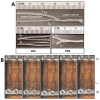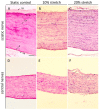Cyclic Stretch of Either PNS or CNS Located Nerves Can Stimulate Neurite Outgrowth
- PMID: 33379276
- PMCID: PMC7824691
- DOI: 10.3390/cells10010032
Cyclic Stretch of Either PNS or CNS Located Nerves Can Stimulate Neurite Outgrowth
Abstract
The central nervous system (CNS) does not recover from traumatic axonal injury, but the peripheral nervous system (PNS) does. We hypothesize that this fundamental difference in regenerative capacity may be based upon the absence of stimulatory mechanical forces in the CNS due to the protective rigidity of the vertebral column and skull. We developed a bioreactor to apply low-strain cyclic axonal stretch to adult rat dorsal root ganglia (DRG) connected to either the peripheral or central nerves in an explant model for inducing axonal growth. In response, larger diameter DRG neurons, mechanoreceptors and proprioceptors showed enhanced neurite outgrowth as well as increased Activating Transcription Factor 3 (ATF3).
Keywords: CNS; DRG; PNS; cyclic stretch; mechanical loading; neurite outgrowth.
Conflict of interest statement
The authors declare no conflict of interest. The funders had no role in the design of the study; in the collection, analyses, or interpretation of data; in the writing of the manuscript, or in the decision to publish the results.
Figures








Similar articles
-
Neuronal age influences the response to neurite outgrowth inhibitory activity in the central and peripheral nervous systems.Brain Res. 1999 Jul 31;836(1-2):49-61. doi: 10.1016/s0006-8993(99)01588-7. Brain Res. 1999. PMID: 10415404
-
The effect of Jun dimerization on neurite outgrowth and motif binding.Mol Cell Neurosci. 2018 Oct;92:114-127. doi: 10.1016/j.mcn.2018.08.001. Epub 2018 Aug 3. Mol Cell Neurosci. 2018. PMID: 30077771 Free PMC article.
-
The transcription factor ATF-3 promotes neurite outgrowth.Mol Cell Neurosci. 2006 May-Jun;32(1-2):143-54. doi: 10.1016/j.mcn.2006.03.005. Epub 2006 May 19. Mol Cell Neurosci. 2006. PMID: 16713293
-
Evidence for cell-contact factor involvement in neurite outgrowth of dorsal root ganglion neurons stimulated by Schwann cells.Exp Physiol. 2019 Oct;104(10):1447-1454. doi: 10.1113/EP087634. Epub 2019 Aug 11. Exp Physiol. 2019. PMID: 31294871
-
Activating Transcription Factor 3 (ATF3) is a Highly Conserved Pro-regenerative Transcription Factor in the Vertebrate Nervous System.Front Cell Dev Biol. 2022 Mar 8;10:824036. doi: 10.3389/fcell.2022.824036. eCollection 2022. Front Cell Dev Biol. 2022. PMID: 35350379 Free PMC article. Review.
Cited by
-
Cyclic Strain and Electrical Co-stimulation Improve Neural Differentiation of Marrow-Derived Mesenchymal Stem Cells.Front Cell Dev Biol. 2021 May 11;9:624755. doi: 10.3389/fcell.2021.624755. eCollection 2021. Front Cell Dev Biol. 2021. PMID: 34055769 Free PMC article.
-
Neuroprotective Effects and Mechanisms of Alpiniae oxyphyllae Fructus, a Medicinal and Edible Homologous Herb: Research Advances.Int J Mol Sci. 2025 Jun 27;26(13):6230. doi: 10.3390/ijms26136230. Int J Mol Sci. 2025. PMID: 40650004 Free PMC article. Review.
-
P2X7 receptor antagonist BBG inhibits endoplasmic reticulum stress and pyroptosis to alleviate postherpetic neuralgia.Mol Cell Biochem. 2021 Sep;476(9):3461-3468. doi: 10.1007/s11010-021-04169-3. Epub 2021 May 12. Mol Cell Biochem. 2021. PMID: 33982210
-
Anti-inflammatory effects of cyclodextrin nanoparticles enable macrophage repolarization and reduce inflammation.Discov Nano. 2024 Dec 21;19(1):211. doi: 10.1186/s11671-024-04175-6. Discov Nano. 2024. PMID: 39707045 Free PMC article.
-
A Brief Review of In Vitro Models for Injury and Regeneration in the Peripheral Nervous System.Int J Mol Sci. 2022 Jan 13;23(2):816. doi: 10.3390/ijms23020816. Int J Mol Sci. 2022. PMID: 35055003 Free PMC article. Review.
References
Publication types
MeSH terms
Substances
LinkOut - more resources
Full Text Sources
Miscellaneous

